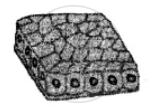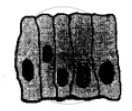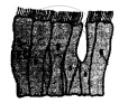Advertisements
Advertisements
प्रश्न
Describe various types of epithelial tissues with the help of labelled diagrams
उत्तर
Epithelial tissue is a tissue made of one or more layers of compactly arranged cells that covers external surface and internal free surface of body organs and which is underlined by a basement membrane. The various types of epithelial tissue along with the diagram are given below:
Simple epithelium
It is composed of single layer of cells which rest on basement membrane. Simple epithelium generally occurs over secretory and absorptive surfaces and forms lining of body cavities, ducts and tubes. Simple epithelium is of several types.
(a) Squamous epithelium: It consists of single layer of flat cells, tightly linked together and have centrally located oval or spherical nucleus. It is also called pavement epithelium. It is found in walls of blood vessels, air sacs of lungs, and lining of eye lens.
(b) Cuboidal epithelium: Cells of cuboidal epithelium are as tall as wide, with centrally placed nucleus. Its main functions are secretion and absorption. It lines sweat gland, thyroid follicles, salivary glands. Brush bordered cuboidal epithelium, i.e., cells having microvilli on their free surface lines proximal part of uriniferous tubule, pancreatic duct, testis and ovary.
(c) Columnar epithelium: Cells are with basally located nucleus. It helps in secretion and absorption. It occurs in lining of intestine, stomach, gall bladder.
(d) Ciliated epithelium: Free surface of columnar and cuboidal cells are covered with cilia. Cilia help in moving fluids, particles, mucus, etc. in a specific direction. It occurs in the inner surface of Fallopian tubules, nasal passage, bronchioles.

(e) Pseudostratified epithelium: It consists of single layer of cells but some cells are shorter than others. Due to difference in size of cells, the epithelium appears 2-3 layered. Pseudostratified columnar epithelium occurs in urethra and parotid salivary gland. Pseudostratified columnar ciliated epithelium (only larger cells ciliated) occurs in lining layer of nasal’ chambers, trachea and large bronchi. It helps in moving mucus and foreign particles

Compoundepithelium/stratifiedepithelium
It is multilayered epithelium where cells of only the lowermost or basal layer are in contact with basement membrane. It provides protection against mechanical and chemical stresses and has limited role in secretion and absorption. It covers dry surface of skin, moist surface of buccal cavity, pharynx, etc. Different types of compound epithelium are
(a) Stratified squamous epithelium: The cells of outer layer are flattened and squamous while the inner layers are cuboidal cells. It is of two types: Non- keratinised lining oesophagus, pharynx, buccal cavity, cornea, vagina and anal canal and keratinised (comified): forming epidermis of skin, hair, horn and nail.

(b) Stratified cuboidal epithelium: The outer layer of cuboidal cells and basal layer of columnar cells. It lines ducts of sweat glands, large salivary and pancreatic ducts.
(c) Stratified columnar epithelium: Both upper and basal layers are made of columnar cells, e.g., epiglottis covering, part of urethra.
(d) Stratified ciliated columnar epithelium: Outer layer consists of ciliated columnar cells and basal layer of columnar cells, e.g., larynx.
Transitional Epithelium
This is stratified epithelium which contains cuboidal or columnar shaped cells, which are thin and stretchable. No basement membrane is present as it would impede stretchability. It lines the inner surface of renal calyces, urinary bladder, ureter. Because of its t distribution, it is also called urothelium.

Glandular epithelium
It consists of specialised epithelial cells which synthesise intracellular macromolecules (protein in pancreas, lipids in adrenal glands, glycoprotein in salivary glands and all the three in mammary glands) and pour out the same in the form of a useful fluid secretion which is different from blood or any other extracellular fluid. Glands can be unicellular or multicellular on the basis of number of cells.
(a) Unicellular glands: Single-celled, e.g., goblet (mucous) cells of respiratory tract and alimentary canal.
(b) Multicellular glands: Consist of cluster of cells, e.g., Salivary glands

On the basis of presence or absence of duct glands can be:
(a) Exocrine glands : These glands pour their secretion through a duct. They secrete milk, saliva, mucus, earwax. e.g., goblet cells, salivary glands, tear glands, gastric glands, intestinal glands.
(b) Endocrine glands: They are ductless glands, which pour their secretions into blood or lymph for reaching the target region. Their secretion is called hormone e.g., pituitary gland, thyroid gland, parathyroid glands, adrenal glands.
(c) Heterocrine glands: Both exocrine and endocrine, e.g., pancreas.
On basis of mode of secretion glands can be:
(a) Merocrine: Secretion is discharged through diffusion, e g., goblet cells, sweat glands.
(b) Apocrine glands: Glandular secretion accumulates in the terminal part of the cell which is pinched off, e.g., mammary glands.
(c) Holocrine glands : The cell filled with secretory product disintegrates during discharge of the product, e.g., sebaceous gland.
Modified epithelium
It is of following types:
(a) Germinal epithelium (generally cuboidal, produces gametes),
(b) Glandular epithelium (columnar or cuboidal secretes chemicals and mucus),
(c) Sensory epithelium or neuroepithelium. Epithelial cells having sensory hair on free surface and connected with nerve fibres on the other surface (generally columnar, receives and conveys stimuli), e.g, nasal epithelium, taste buds, retina, sensory spots of internal ear.
(d) Pigmented epithelium – The cells possess melanin granules, e.g, retinal layer in contact with choroid of eye
APPEARS IN
संबंधित प्रश्न
Based on the following information, identify the three types of epithelial tissue in the figures given below :
| a |  |
b |  |
c |  |
(1) Cuboidal epithelium: It consists of a single layer of cuboidal cells.
(2) Columnar epithelium: It is composed of tall, cylindrical cells with oval nuclei usually placed at the base of the cells.
(3) Ciliated epithelium: It consists of cells being hair-like cilia on their free surface.
The following statement is wrong. Rewrite it correctly by changing either one or two words.
Glandular epithelium is present in kidneys.
Name the kind of cells found in the following place:
Inner lining of the wind pipe
Name any one body part where ciliated epithelium is found in humans. What is its function?
Name the tissues found
at the outer layer of skin.
Answer the following question.
What is cell junction?
Prevention of substances from leaking across the tissue is provided by ______.
Fats are stored in human body as
A long tree has several branches. The tissue that helps in the side ways conduction of water in the branches is
If a potted plant is covered with a glass jar, water vapours appear on the wall of glass jar. Explain why?
Differentiate between sclerenchyma and parenchyma tissues. Draw well labelled diagram.
Give reasons for
Intercellular spaces are absent in sclerenchymatous tissues.
In a certain type of cell division, the diploid number of chromosomes is reduced to half. This kind of division occurs in ______.
______ epithelium is seen in sweat glands.
An epithelial layer does not allow the regulation of materials between the body and the external environment.
Glandular epithelium gives a stratified appearance.
Epithelium founds in the lining of stomach and intestine is
Stratified epithelial cells have limited role in secretion. Justify their role in our skin.
Write the appropriate type of tissues in column B according to the functions mentioned in column A.
| Column A | Column B |
| a. Secretion and absorption | i. ______ |
| b. Protective covering | ii. ______ |
| c. Linking and supporting framework | iii. ______ |
